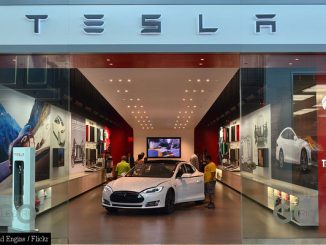- John Murphy of BofA Securities appeared on CNBC’s ‘Squawk Box’ this morning to highlight Tesla’s aging product lineup – Model 3 (8 years) and Model Y (5 years) – which lags behind industry norms and Chinese rivals’ 2-3 year cycles. He also expressed doubts about a $30,000 vehicle expected by mid-2025.
- Murphy tied a shrinking buyer pool to Elon Musk’s polarizing image, while pegging 50% of Tesla’s valuation to FSD and Robotaxi potential, envisioning faster travel via autonomous tech boosting speed limits, though near-term gains may require dedicated lanes amid human-AI traffic challenges.
- He framed FSD as a societal boon akin to past mobility leaps, potentially licensable to rivals, but questioned rapid adoption without infrastructure like 5G-smart roads, seeing Musk’s administration ties as a catalyst despite Tesla’s current product and European demand woes.

Tesla’s (TSLA) stock, up $4.45 or 1.47% to $307.30 in Wednesday trading after shedding over 8% the prior day, reflects a volatile moment for the EV giant, a topic John Murphy, BofA Securities senior auto analyst, tackled on CNBC’s ‘Squawk Box,’ tying its struggles to an aging product lineup – the Model 3 at eight years, Model Y at five – far outpacing the industry’s typical five-to-six-year refresh cycles. Murphy pointed to fierce Chinese competition, with product turnovers every two to three years, and skepticism about Tesla’s promised $30,000 entry-level vehicle due in mid-2025, noting the absence of a prototype raises doubts despite claims of imminent production. He suggested Elon Musk’s polarizing public persona, often spotlighted for ventures like DOGE rather than Tesla, may be shrinking the buyer pool, particularly in Europe, where political leanings don’t fully offset losses with Trump-aligned truck and Internal Combustion Engine (ICE)-focused consumers.
The valuation debate dominated Murphy’s analysis, with 50% of BofA’s price target hinging on Full Self-Driving (FSD) and Robotaxi potential, not just car sales—a nod to Tesla’s nearly a trillion market cap defying traditional automaker metrics even after dipping below that threshold. He envisions FSD’s real value in slashing travel times, potentially boosting speed limits if autonomous tech proves safer, though near-term gains might lean on dedicated highway lanes akin to HOV setups, challenging the mixed human-AI traffic reality—barriers like Jersey walls could help, but a smart 5G road network tethering vehicles is the longer play. Murphy sees Tesla’s FSD as a societal game-changer, not just a company lifeline, arguing it could mirror the Model T’s early 1900s impact or China’s GDP surge from faster mobility, though he conceded high-speed adoption might lag without massive infrastructure leaps.
Murphy’s take blends caution with ambition—Tesla’s stale lineup and Musk’s distractions drag consideration sets down, yet FSD’s promise could redefine mobility, possibly licensing to rivals like Ford or Toyota, though he doubts mass rollout within four years absent a policy push, hinting at the current administration’s Musk ties as a wild card. The stock’s Wednesday bounce contrasts Tuesday’s 8% dip, reflecting a market wrestling with Tesla’s dual identity: a carmaker overdue for a refresh and a tech titan betting on autonomy to justify its outsized valuation. Europe’s softening demand and China’s EV onslaught loom large, but Murphy insists FSD’s untapped utility—shifting cars from planes and trains for trips like New York to Boston—could unlock GDP-scale growth if the U.S. seizes the tech edge over global rivals.
WallStreetPit does not provide investment advice. All rights reserved.
- Bulenox: Get 45% to 91% OFF ... Use Discount Code: UNO
- Risk Our Money Not Yours | Get 50% to 90% OFF ... Use Discount Code: MMBVBKSM
Disclaimer: This page contains affiliate links. If you choose to make a purchase after clicking a link, we may receive a commission at no additional cost to you. Thank you for your support!




Leave a Reply